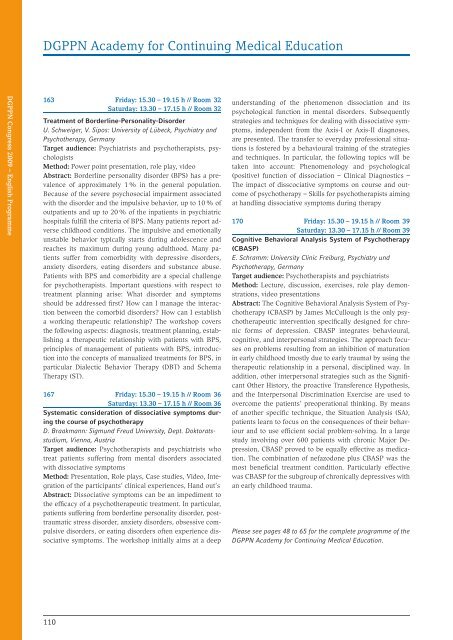Die aktuelle Orientierungshilfe in 5 Bänden - Vlaamse Vereniging ...
Die aktuelle Orientierungshilfe in 5 Bänden - Vlaamse Vereniging ...
Die aktuelle Orientierungshilfe in 5 Bänden - Vlaamse Vereniging ...
Sie wollen auch ein ePaper? Erhöhen Sie die Reichweite Ihrer Titel.
YUMPU macht aus Druck-PDFs automatisch weboptimierte ePaper, die Google liebt.
DGPPN Congress 2009 – English Programme<br />
DGPPN Academy for Cont<strong>in</strong>u<strong>in</strong>g Medical Education<br />
163 Friday: 15.30 – 19.15 h // Room 32<br />
Saturday: 13.30 – 17.15 h // Room 32<br />
Treatment of Borderl<strong>in</strong>ePersonalityDisorder<br />
U. Schweiger, V. Sipos: University of Lübeck, Psychiatry and<br />
Psychotherapy, Germany<br />
Target audience: Psychiatrists and psychotherapists, psychologists<br />
Method: Power po<strong>in</strong>t presentation, role play, video<br />
Abstract: Borderl<strong>in</strong>e personality disorder (BPS) has a prevalence<br />
of approximately 1 % <strong>in</strong> the general population.<br />
Because of the severe psychosocial impairment associated<br />
with the disorder and the impulsive behavior, up to 10 % of<br />
outpatients and up to 20 % of the <strong>in</strong>pa tients <strong>in</strong> psychiatric<br />
hospitals fulfill the criteria of BPS. Many patients report adverse<br />
childhood conditions. The impulsive and emotionally<br />
unstable behavior typically starts dur<strong>in</strong>g adolescence and<br />
reaches its maximum dur<strong>in</strong>g young adulthood. Many patients<br />
suffer from comorbidity with depressive disorders,<br />
anxiety disorders, eat<strong>in</strong>g disorders and substance abuse.<br />
Patients with BPS and comorbidity are a special challenge<br />
for psychotherapists. Important questions with respect to<br />
treatment plann<strong>in</strong>g arise: What disorder and symptoms<br />
should be addressed first? How can I manage the <strong>in</strong>teraction<br />
between the comorbid disorders? How can I establish<br />
a work<strong>in</strong>g therapeutic relationship? The workshop covers<br />
the follow<strong>in</strong>g aspects: diagnosis, treatment plann<strong>in</strong>g, establish<strong>in</strong>g<br />
a therapeutic relationship with patients with BPS,<br />
pr<strong>in</strong>ciples of management of patients with BPS, <strong>in</strong>troduction<br />
<strong>in</strong>to the concepts of manualized treatments for BPS, <strong>in</strong><br />
particular Dialectic Behavior Therapy (DBT) and Schema<br />
Therapy (ST).<br />
167 Friday: 15.30 – 19.15 h // Room 36<br />
Saturday: 13.30 – 17.15 h // Room 36<br />
Systematic consideration of dissociative symptoms dur<strong>in</strong>g<br />
the course of psychotherapy<br />
D. Braakmann: Sigmund Freud University, Dept. Doktoratsstudium,<br />
Vienna, Austria<br />
Target audience: Psychotherapists and psychiatrists who<br />
treat pa tients suffer<strong>in</strong>g from mental disorders associated<br />
with dissociative symptoms<br />
Method: Presentation, Role plays, Case studies, Video, Integration<br />
of the participants‘ cl<strong>in</strong>ical experiences, Hand out‘s<br />
Abstract: Dissociative symptoms can be an impediment to<br />
the efficacy of a psychotherapeutic treatment. In particular,<br />
patients suffer<strong>in</strong>g from borderl<strong>in</strong>e personality disorder, posttraumatic<br />
stress disorder, anxiety disorders, obsessive compulsive<br />
disorders, or eat<strong>in</strong>g disorders often experience dissociative<br />
symptoms. The workshop <strong>in</strong>itially aims at a deep<br />
110<br />
understand<strong>in</strong>g of the phenomenon dissociation and its<br />
psycho logical function <strong>in</strong> mental disorders. Subsequently<br />
strategies and techniques for deal<strong>in</strong>g with dissociative symptoms,<br />
<strong>in</strong>dependent from the AxisI or AxisII diagnoses,<br />
are presented. The transfer to everyday professional situations<br />
is foster ed by a behavioural tra<strong>in</strong><strong>in</strong>g of the strategies<br />
and techniques. In particular, the follow<strong>in</strong>g topics will be<br />
taken <strong>in</strong>to account: Phenomenology and psychological<br />
(positive) function of dissociation – Cl<strong>in</strong>ical Diagnostics –<br />
The impact of disscociative symptoms on course and outcome<br />
of psychotherapy – Skills for psychotherapists aim<strong>in</strong>g<br />
at handl<strong>in</strong>g dissociative symptoms dur<strong>in</strong>g therapy<br />
170 Friday: 15.30 – 19.15 h // Room 39<br />
Saturday: 13.30 – 17.15 h // Room 39<br />
Cognitive Behavioral Analysis System of Psychotherapy<br />
(CBASP)<br />
E. Schramm: University Cl<strong>in</strong>ic Freiburg, Psychiatry und<br />
Psycho therapy, Germany<br />
Target audience: Psychotherapists and psychiatrists<br />
Method: Lecture, discussion, exercises, role play demonstrations,<br />
video presentations<br />
Abstract: The Cognitive Behavioral Analysis System of Psychotherapy<br />
(CBASP) by James McCullough is the only psychotherapeutic<br />
<strong>in</strong>tervention specifically designed for chronic<br />
forms of depression. CBASP <strong>in</strong>tegrates behavioural,<br />
cognitive, and <strong>in</strong>terpersonal strategies. The approach focuses<br />
on problems result<strong>in</strong>g from an <strong>in</strong>hibition of maturation<br />
<strong>in</strong> early childhood (mostly due to early trauma) by us<strong>in</strong>g the<br />
therapeutic relationship <strong>in</strong> a personal, discipl<strong>in</strong>ed way. In<br />
addition, other <strong>in</strong>terpersonal strategies such as the Significant<br />
Other History, the proactive Transference Hypothesis,<br />
and the Interpersonal Discrim<strong>in</strong>ation Exercise are used to<br />
overcome the patients‘ preoperational th<strong>in</strong>k<strong>in</strong>g. By means<br />
of another specific technique, the Situation Analysis (SA),<br />
pa tients learn to focus on the consequences of their behaviour<br />
and to use efficient so cial problemsolv<strong>in</strong>g. In a large<br />
study <strong>in</strong>volv<strong>in</strong>g over 600 patients with chronic Major Depression,<br />
CBASP proved to be equally effective as medication.<br />
The comb<strong>in</strong>ation of nefazodone plus CBASP was the<br />
most beneficial treatment condition. Particularly effective<br />
was CBASP for the subgroup of chronically depressives with<br />
an early childhood trauma.<br />
Please see pages 48 to 65 for the complete programme of the<br />
DGPPN Academy for Cont<strong>in</strong>u<strong>in</strong>g Medical Education.




